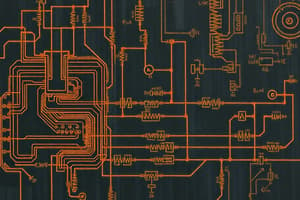Podcast
Questions and Answers
What is the unit of measurement for current?
What is the unit of measurement for current?
- Volts
- Amperes (correct)
- Watts
- Ohms
In a series circuit, the voltage is the same across all components.
In a series circuit, the voltage is the same across all components.
False (B)
What is the formula for calculating power in an electrical circuit?
What is the formula for calculating power in an electrical circuit?
P = V × I
The opposition to the flow of current is known as ______.
The opposition to the flow of current is known as ______.
Match the following circuit components with their primary functions:
Match the following circuit components with their primary functions:
Which of the following best describes Kirchhoff's Current Law?
Which of the following best describes Kirchhoff's Current Law?
AC stands for Alternating Current and flows in one direction only.
AC stands for Alternating Current and flows in one direction only.
Name one primary use of a multimeter in electronics.
Name one primary use of a multimeter in electronics.
A ______ is used to control the flow of current in a circuit.
A ______ is used to control the flow of current in a circuit.
Which of the following is a primary application of basic electronics?
Which of the following is a primary application of basic electronics?
Flashcards are hidden until you start studying
Study Notes
Fundamental Concepts of Electronics and Electrical
Basic Terms:
- Voltage (V): The electric potential difference between two points; measured in volts (V).
- Current (I): The flow of electric charge; measured in amperes (A).
- Resistance (R): Opposition to the flow of current; measured in ohms (Ω).
- Power (P): The rate at which electrical energy is consumed; calculated as P = V × I; measured in watts (W).
Ohm’s Law:
- Formula: V = I × R
- Describes the relationship between voltage, current, and resistance.
Circuit Types:
- Series Circuit: Components connected in a single path; current is the same through all components.
- Parallel Circuit: Components connected across common points; voltage is the same across all components.
Basic Components:
- Resistor: Limits current; measured in ohms.
- Capacitor: Stores electrical energy; measured in farads (F).
- Inductor: Stores energy in a magnetic field; measured in henries (H).
- Diode: Allows current to flow in one direction only.
- Transistor: Can amplify or switch electronic signals.
Electrical Properties:
- AC (Alternating Current): Current changes direction periodically; typically used in homes.
- DC (Direct Current): Current flows in one direction; commonly found in batteries.
Basic Circuit Components:
- Battery: Provides DC voltage; stores chemical energy.
- Switch: Controls the flow of current within a circuit.
- LED (Light Emitting Diode): Emits light when current flows through it; operates as a diode.
Kirchhoff’s Laws:
- Kirchhoff's Current Law (KCL): The total current entering a junction equals the total current leaving the junction.
- Kirchhoff's Voltage Law (KVL): The total voltage around a closed loop equals zero.
Basic Tools for Electronics:
- Multimeter: Measures voltage, current, and resistance.
- Oscilloscope: Displays voltage signals over time.
- Breadboard: Used for prototyping circuits without soldering.
Safety Tips:
- Always turn off power before working on circuits.
- Use appropriate ratings for components.
- Be cautious with high voltages and currents.
Applications of Basic Electronics:
- Power supplies
- Signal processing
- Communication devices
- Home appliances
Understanding these fundamental concepts lays the groundwork for exploring more advanced topics in electronics and electrical engineering.
Basic Terms
- Voltage is the potential difference between two points, measured in volts (V).
- Current is the flow of electric charge, measured in amperes (A).
- Resistance is the opposition to the flow of current, measured in ohms (Ω).
- Power is the rate at which electrical energy is consumed, calculated as P = V × I, and measured in watts (W).
Ohm’s Law
- The relationship between voltage, current, and resistance is described by Ohm's Law: V = I × R.
Circuit Types
- In a series circuit components are connected in a single path, and current flows through all components equally.
- In a parallel circuit, components are connected across common points, and the voltage is the same across all components.
Basic Components
- Resistors limit current and are measured in ohms.
- Capacitors store electrical energy and are measured in farads (F).
- Inductors store energy in a magnetic field and are measured in henries (H).
- Diodes allow current to flow in one direction only.
- Transistors amplify or switch electronic signals.
Electrical Properties
- Alternating Current (AC) changes direction periodically and is commonly used in homes.
- Direct Current (DC) flows in one direction and is commonly found in batteries.
Basic Circuit Components
- Batteries provide DC voltage and store chemical energy.
- Switches control current flow within a circuit.
- LEDs (Light Emitting Diodes) emit light when current passes through them and function as a diode.
Kirchhoff’s Laws
- Kirchhoff's Current Law (KCL) states that the total current entering a junction equals the total current leaving the junction.
- Kirchhoff's Voltage Law (KVL) states that the total voltage around a closed loop equals zero.
Basic Tools for Electronics
- Multimeters measure voltage, current, and resistance.
- Oscilloscopes display voltage signals over time.
- Breadboards are used for prototyping circuits without soldering.
Safety Tips
- Always turn off the power before working on circuits.
- Use components with appropriate ratings.
- Be cautious with high voltages and currents.
Applications of Basic Electronics
- Power supplies
- Signal processing
- Communication devices
- Home appliances
Studying That Suits You
Use AI to generate personalized quizzes and flashcards to suit your learning preferences.



